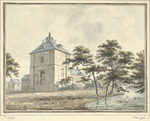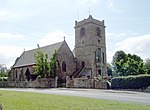Westbury railway station (Shropshire)

Westbury railway station was a station in Westbury, Shropshire, England. The station was opened in 1862 by the Shrewsbury and Welshpool Railway company, later coming under the joint control of the Great Western Railway and the London and North Western Railway. It closed (along with all the other intermediate stations) on 12 September 1960, though it retained its passing loop and signal box until 1988, when the modernisation scheme for the line saw Radio Electronic Token Block signalling commissioned, all remaining manual signal boxes closed and control passed to the signalling centre at Machynlleth. Just a year earlier, the loop was the site of a head-on collision between two passenger trains after one passed a signal at danger. One of the two Class 150 Diesel Multiple Units involved was derailed and 37 people were injured.The former main building survives here in occupation as a private house, along with the now automatic level crossing over the B4387 road.
Excerpt from the Wikipedia article Westbury railway station (Shropshire) (License: CC BY-SA 3.0, Authors, Images).Westbury railway station (Shropshire)
B4387,
Geographical coordinates (GPS) Address External links Nearby Places Show on map
Geographical coordinates (GPS)
| Latitude | Longitude |
|---|---|
| N 52.6925 ° | E -2.9684 ° |
Address
Westbury
B4387
SY5 9DA , Alberbury with Cardeston
England, United Kingdom
Open on Google Maps









